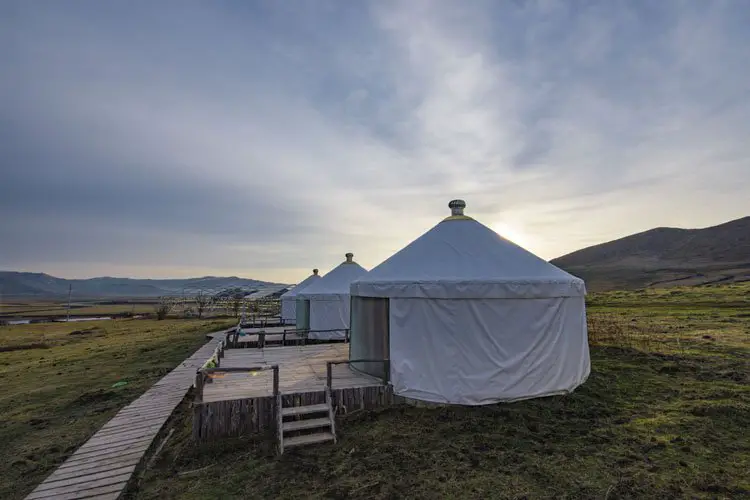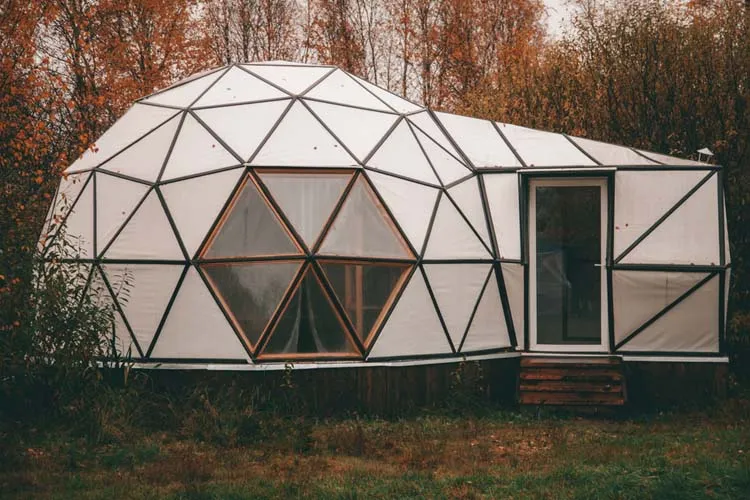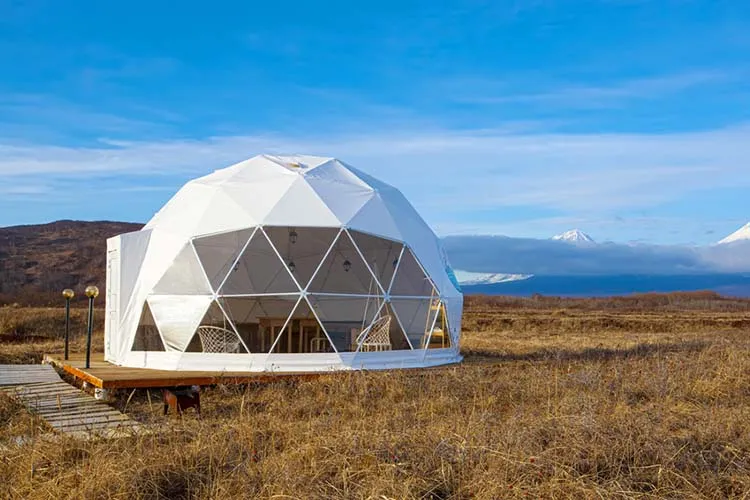If you’re considering an alternate housing in this crazy real estate market, you might be looking at yurts and geodesic domes.
A common factor for both types of dwellings is that they favor a minimalist lifestyle and are found in nature rather than urban areas. If you are planning to build one, a geodesic dome is technically more complicated (some geometry skills needed), while a yurt may be slightly easier.
Comparing geodesic dome homes vs yurts provides some interesting differences and similarities. If you plan to move out of traditional housing into one of these types of dwellings, you would do well to learn more about them. Here we compare yurts vs geodesic domes.
Yurts vs Geodesic Domes: Pros and Cons
Yurts and geodesic domes each have pros and cons. Let’s take a look at the advantages and disadvantages of yurts vs geodesic domes:
Yurts: Pros
Peaceful Existence
Living in a yurt can be a very peaceful experience, often found in nature like the mountains, the forest or rural areas. Yurts are often a place to get away from modern life and even go off -grid.
Strong Structure
The design of a yurt is stronger than you might think and built to withstand pretty heavy snow loads – which is why you’ll often find them near ski resorts or back country snow areas. Due to their rounded shape, yurts also withstand high winds quite well.
Minimalistic Lifestyle
Yurts provide a simple and humble lifestyle if you prefer a minimalist lifestyle. While yurts can be build with interior walls and all the modern conveniences, their open floor plan generally lends itself to simple living.
Quick to Build
You can build a yurt in a relatively short time depending on the size and complexity of the structure. Overall, they are quicker and require less resources than a traditional home.
Cost-effective Housing
Yurts are among the cheapest form of dwelling you can find. You can build a yurt for as low as $7,500 which is significantly cheaper than the smallest tiny house and infinitely cheaper than traditional houses.
Cheaper to Heat and Cool
Yurts cost considerably less to heat and cool than traditional American homes. Because of the relatively lower internal volume, the air inside a yurt heats or cools down faster than any other type of dwelling.
Passive Income Source
Last but not the least, even if you don’t live in your yurt full-time, it can provide rental income. If you place your yurt in a desirable location, with some natural beauty nearby, you can earn considerable rental income for guests looking for a unique experience.

Yurts: Cons
Poor Temperature Control
Although a yurt heats or cools down fast, you may find it difficult to balance it with the outside temperatures. In the cold weather, you can warm it with a woodstove and use fans and air conditioners in the summer. But it may not be as easy to do as in a regular home as it has a high peak.
Exposure to Pests
Most yurts are built in remote areas so are prone to bugs, pests, and mosquitoes. It can take some time to get used to the presence of these critters, which in all fairness, were there before you!
Fire Hazard
Because we use wood-burning stoves in yurts, it can be a fire hazard. Most of the material that makes a yurt is combustible. It is an invitation to a fire disaster if you do not take adequate precautions.
Lack of Privacy
While the open air plan of a yurt is part of its timeless appeal, the airy design does not lend itself to much privacy unless you build internal walls. So if you are sharing with a friends or family, you might need to take private conversations outside to avoid any awkwardness.
Lack of Storage Space
Because of the round design, storage can be an issue. While there are some creative solutions to any storage problem, it’s something to take into account if you tend to need a lot of storage and closet space.

Geodesic Domes Pros
Structural Integrity
The prime advantage of a geodesic dome is its mechanical strength and resistance to natural disasters. A geodesic dome withstands wind and snow effectively. It can even survive an earthquake or a tornado. A dome made of triangles is the strongest dome structure that you can build. The triangle is a mechanically stable shape which is why you will see them form the basis of heavy load-bearing structures like railway bridges.
Energy-efficient Structures
Geodesic domes are energy-efficient. You can keep an even temperature within the interior of the dome. It makes it even more energy-efficient than traditional American homes.
Rapid Construction
Geodesic domes can be set up in a surprisingly short time. Being lightweight they can be transported easily from one location to another.
Cost-effective Housing Solution
A geodesic dome home costs a fraction of a traditional house – even a tiny house. Material like heat-pressed softwoods is cheaper than brick and mortar.
Easy to Install
Geodesic homes also come in the form of kits which can be built relatively quickly and easily.
Unique Appearance
When built well, a geodesic home can be a statement piece that is unique.
View this post on Instagram
Geodesic Homes: Cons
Difficult to Install Certain Structures
Chimneys, for example, can prove to be difficult to install, particularly in larger dome homes. Adding stairs or fire escapes for multi-level domes is a challenge. It can also be challenging to create divisions and rooms within the structure.
Getting Planning Permission
Check with your local municipality on building a geodesic home in your area. Some neighborhoods don’t allow them even in more remote areas.
Difficult to Install Appliances and Fixtures
Similar to yurts, the round design can present some challenges such as aligning shelves, storage and appliances to the curved surfaces of your dome home.
Leakage Issues
One of the primary downsides of geodesic homes is that are prone to leaks. Use local builders and craftsmen who have the experience in installing this type of structure is one way to avoid this issue.
Expensive Maintenance and Repair
Roof Leakages are common in geodesic homes as we mentioned above. If you have to get a leaky roof repaired it is going to be expensive. Most of the roof area of a geodesic home is steep and high which makes it challenging and expensive to repair.
Difficult Acoustics and Lack of Privacy
Regarding acoustics, you might find an echo generated within your dwelling. This echo and carrying sound compromises privacy which can make private conversations more difficult.
Resale Challenges
If you were to sell your property you would have to sell it to someone equally enthusiastic about geodesic domes. The unique shape of these homes may reduce the number of potential buyers considerably.
Conclusion
Both yurts and geodesic domes are unique in several ways with their own pros and cons. But if you choose to live in either type of dwelling it will definitely be a unique and rewarding experience.

